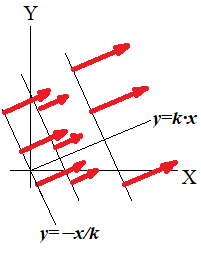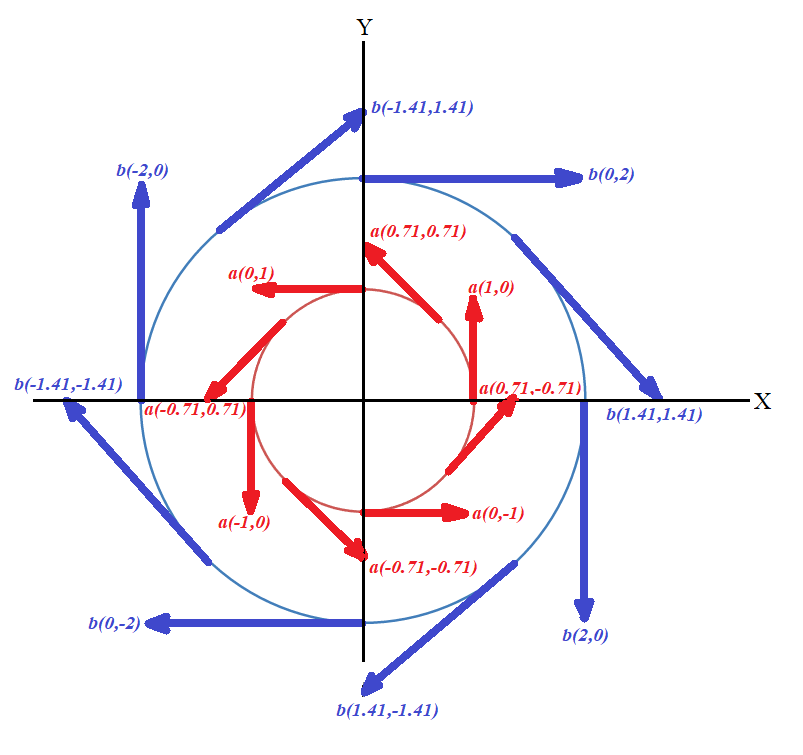Curl in 2D
Previous lectures addressed different usages of a pseudo-vector (a triad, a triplet, a set or simply a vector) of partial differentiation operators
∇ = {∂/∂x, ∂/∂y, ∂/∂z}.
We have discussed a gradient of the scalar field that looks like a multiplication of "vector" ∇ by scalar F(x,y,z)
as follows:
grad F(x,y,z) = ∇F =
= {∂F/∂x, ∂F/∂y, ∂F/∂z}
which is a vector.
We have also introduced a divergence of the vector field that looks like a scalar (dot) product of "vector" ∇ and vector V(x,y,z) with components
{Vx(x,y,z),Vy(x,y,z),Vz(x,y,z)}
as follows:
div V(x,y,z) = (∇·V) =
= ∂Vx/∂x + ∂Vy/∂y + ∂Vz/∂z
which is a scalar.
Our next goal is to introduce yet another usage of a symbol ("vector") ∇ for vector fields, which will describe an operation similar to a vector (cross) product of pseudo-vector ∇ and vector V(x,y,z) in three-dimensional space, that is
curl V(x,y,z) = ∇⨯V
which is a vector.
The concept of a curl in three-dimensional case, where it's the most practical, is easier to begin explaining in two-dimensional world.
Imagine a vector field on the XY-plane, assigning some vector V(x,y) (direction and magnitude) to each point {x,y} on this plane.
For example, if our plane is a surface of water (flat surface, no waves), the vector field V(x,y) can represent the velocity of each dust particle on this surface at some moment in time, as all these particles are chaotically sliding around a water surface.
As in other cases, we consider vector V(x,y) as represented by its two components along X- and Y-coordinates:
V(x,y) = {Vx(x,y), Vy(x,y)}
The intuitive understanding of a curl at some point of a two-dimensional field (a plane) is that, if we place a tiny paddle wheel with the axis perpendicular to our plane into some point, it will or will not rotate by the vectors of the field, interpreted as forces.
The direction and speed of rotation are expressed as a curl at that point on a plane at that time moment (positive for counterclockwise rotation, negative for clockwise and zero if there is no rotation at all).
The formal definition of a curl in a two-dimensional case is
curl V(x,y) =
= ∂Vy(x,y)/∂x − ∂Vx(x,y)/∂y
There is a logical base for this definition.
The term ∂Vy(x,y)/∂x characterizes how fast and in what direction (increases, pulling up or decreases pulling down) the Y-components of the vector field is changing if we step to the right by infinitesimal increment of argument x.
The term ∂Vx(x,y)/∂y characterizes how fast and in what direction (increases, pulling right or decreases pulling left) the X-components of the vector field is changing if we step up by infinitesimal increment of argument y.
Their difference characterizes whether the vector field curves towards X- or Y-axis at point {x,y}.
In other words, if we have a perpendicular to our XY-plane at point {x,y}, curl indicates whether there is a vector field's tendency to rotate around this point clockwise (towards X-axis) or counterclockwise (towards Y-axis).
Now let's analyze what this formula represents.
Unidirectional Vector Field
Let's start with constant direction and magnitude vector field
V(x,y) = {Vx(x,y), Vy(x,y)}
It can be described as
Vx(x,y)=a, Vy(x,y)=b
for all pairs {x,y}.
Intuitively, there is no curl in this field.
Indeed,
∂Vy(x,y)/∂x = 0
∂Vx(x,y)/∂y = 0
Therefore,
curl V(x,y) = 0
Consider now a unidirectional vector field (all vectors are parallel to some line, like y=k·x) with variable magnitude at different points.
If two infinitesimally closed to each other points, not lying on the same line as the direction of the vector field, have vectors of the same direction but different magnitude, the tiny pedal wheel positioned at that point would still rotate.
The absence of a rotation of a tiny pedal wheel that can be placed at any point on a plane necessitates that the magnitude of neighboring vectors along parallel lines must be the same (so, there is no momentum of rotation).
If we draw a line perpendicular to a graph of a function y=k·x, which is y=−x/k, the magnitude of parallel vectors on the same distance from that perpendicular line (in other words, on the same front line) must be the same.
This is illustrated on a picture below with the length of red lines corresponding to a magnitude of collinear vectors, equal for vectors on the same front line.

To prove that this field has curl equaled to zero, let's change the coordinate axes.
The fact of rotation or not rotation of our tiny pedal wheel does not depend on coordinates, so let's choose the new X-axis along the line y=k·x in old coordinates and Y-axis - along a line y=−x/k.
In this new system of coordinates all vectors are directed along the new X-axis, their new Y-coordinate is always zero.
Now our vector field looks like
V(x,y) = {Vx(x,y), 0}
The requirement of all vectors on the same front line to have the same magnitude means that all vectors with the same X-coordinate (x=a) have the same magnitude (equaled to Vx(a,y), regardless of Y-coordinate y.
Let's calculate the curl of this vector field at any point.
Again, the definition of a curl is
curl V(x,y) =
= ∂Vy(x,y)/∂x − ∂Vx(x,y)/∂y
Since Vy(x,y) = 0 at any point on a plane,
∂Vy(x,y)/∂x = 0
The situation with ∂Vx(x,y)/∂y is only slightly more complex.
Recall that the definition of a partial derivative of Vx(x,y) by argument y means
lim[Vx(x,y+Δy)−Vx(x,y)]/Δy
as Δy→0.
But the value of Vx(x,y), as we stated above, does not depend on argument y and is the same for all values of y for any fixed argument x.
Therefore, the difference Vx(x,y+Δy)−Vx(x,y) is always zero, which makes ∂Vx(x,y)/∂y to be zero as well.
So, curl is zero for this unidirectional vector field with the same magnitude of vectors lying on the same front line.
Circular Vector Field
Let's consider a circular vector field with direction of vectors changing from point to point, always perpendicular to a radius to this point from the origin of coordinates {0,0}.
The radius vector to a point with coordinates {x,y} is
r={x,y}.
The perpendicular vector must have a scalar product with r equal to zero.
There are many examples of a vector field that at any point is perpendicular to a radius-vector to this point from the origin of coordinates.
For example,
You can check that their scalar product with r={x,y} is zero.
We, as an example, choose a simpler case of vectors
Indeed, the scalar (dot) product of r with any of them is
(r·a) = (r·b) = −x·y+x·y = 0.
The magnitude of the vector field a(x,y) is √x²+y² and is growing, as a point {x,y} moves farther from the origin of coordinates.

(click right mouse and open this picture in another tab to see it in full format)
Quick analysis shows that vector field a(x,y) defines counterclockwise circulation, while b(x,y) defines clockwise circulation of a vector field.
Let's calculate the curl of both fields.
Vector a(x,y)={−y,x} has components
ax(x,y) = −y
ay(x,y) = x
Therefore,
curl a(x,y) =
= ∂ay(x,y)/∂x − ∂ax(x,y)/∂y =
= ∂x/∂x − ∂(−y)/∂y =
= 1 + 1 = 2 (positive)
Vector b(x,y)={y,−x} has components
bx(x,y) = y
by(x,y) = −x
Therefore,
curl b(x,y) =
= ∂by(x,y)/∂x − ∂bx(x,y)/∂y =
= ∂(−x)/∂x − ∂y/∂y =
= −1 − 1 = −2 (negative)
The constant curl throughout an entire vector field a(x,y) or b(x,y) is an interesting phenomenon.
On one hand, the curvature of circles of the vector field is diminishes, as the distance from a center increases.
On the other hand, the strength (magnitude) of the vector field is increasing with the distance from the center.
These two factors balance each other and the "curliness" of the field stays the same.
As an analogy, going in a circle of a small radius with a lower speed and going in a circle of a large radius with a higher speed result in similar feelings of centripetal force.
Curl in 2D as Rotation
The last example of a circular vector field rotating around the origin of coordinates can be viewed as rotation within XY-plane around Z-axis.
In theory, any circulation of a vector field within XY-plane around any point can be viewed as rotation around a perpendicular to XY-plane at that point. Then the curl of the vector field at that point can be represented as a vector perpendicular to XY-plane (that is, parallel to Z-axis) with a magnitude equal to the value of a curl at that point.
Just as an association, remember the representation of the angular speed of rotation as a vector perpendicular to the plane of rotation, having a magnitude equal to the angular speed - angular velocity vector. This vector representation of angular speed of rotation was just for a convenience of representing other concepts related to rotation.
The similar vector representation of a curl in two-dimensional case as a vector perpendicular to a plane of rotation is also a convenience, that, in particular, will be used for three-dimensional case.


No comments:
Post a Comment